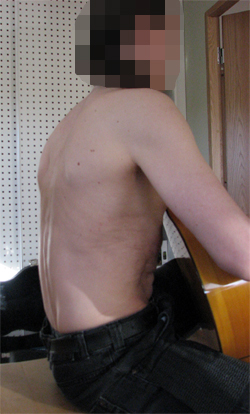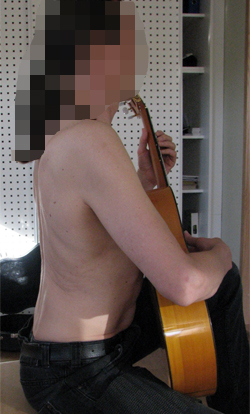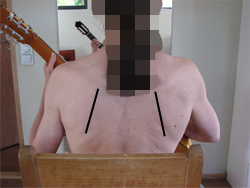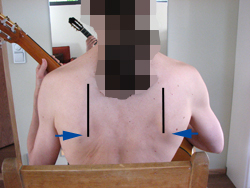Guitar - harjoittelu
Guitar
Read the Ergonomics Overview first.
The body's centre position is the basic position to which the musician always returns. In the centre position, the spine maintains its natural curves. Spinal curves vary between individuals; in the centre position, the backs and hips of different people may look different.
To find a good ergonomic posture, the position of the pelvis should be examined first. The pelvis should be maintained in the centre position, which means sitting on the ischia. Keeping the pelvis in the centre enables a natural spine position, which is the basis for a relaxed and controlled playing technique.
|
The pelvis tilts backwards, the spine curves and twists to the left; insufficient support in the shoulder blade. |
The pelvis and the spine are in the centre position; the shoulder blades are in a vertical position and supported against the rib cage. |
If the guitarist uses a foot rest, the muscles extending over the hip joint and the pelvis should be sufficiently flexible, so that when the hip is flexed, the pelvis and the lumbar spine do not tilt backwards. The flexibility of the hip and pelvic region is very individual; some musicians benefit from a foot rest, while for others, it can affect their posture. It is recommended that "stiffer" musicians use a thigh rest instead of a foot rest, or a combination of a thigh rest and a low foot rest.
Guitarists are typically prone to twisting their body to the left; looking at the left hand while playing increases the twisting. Twisting to the left affects the support muscles of the left shoulder blade and the entire limb, and should thus be avoided. A typical faulty position of the shoulder blade is a forward tilt, with the shoulder blade winging off and its medial inferior angle (bottom corner) twisting towards the spine.
|
The shoulder blades are well supported against the rib cage, with the medial inferior angle (bottom corners) rolling outwards. |
Insufficient support of the shoulder blade; the shoulder blade tilts forward, drops, wings off of the rib cage, and the bottom corner rotates towards the spine. |
As a result of the incorrect position, the arm becomes tense, affecting finger control. Twisting can be prevented with good control of the support muscles. These muscles work best when the pelvis and the spine are in the centre position.
The right shoulder blade should be supported so that the blade and the shoulder do not tilt forward with the arm, but remain in a vertical position, against the ribs. If the shoulder blade tilts forward, it affects the technical control of the right hand, and the whole arm becomes tenser.
When the wrists are in the centre position, the fingers function and tolerate strain in an optimal way. For wrists, the centre position is a 15 degree extension combined with a 15 degree tilt towards the little finger. This position facilitates the good functioning of the palmar muscles and allows for the best possible reach of the hand. For the left hand, the wrist angle can be improved by bringing the guitar upwards and closer to the body. For the right hand, the wrist angle can be improved with good support in the shoulder blade, bringing the arm sufficiently far forward and to the side.
Guitarists should pay special attention to the position of the thumb. The thumb should remain curved, and the base joint muscles should be engaged. The base joint of the thumb is located on the wrist, and its movement is controlled by the palmar muscles. These muscles also support the middle thumb joint. A loose middle joint and a faulty thumb position (excessive extension/flexing) are a relatively typical error among guitarists. The faulty position increases strain in the thumb area and also affects the other fingers.




